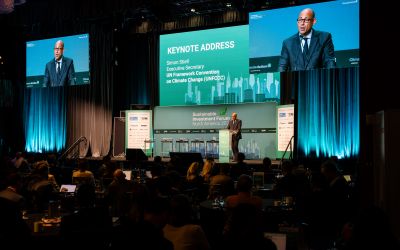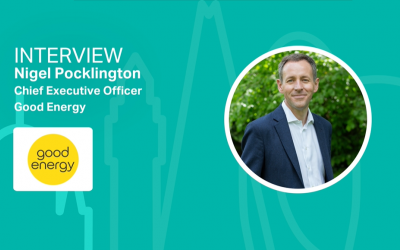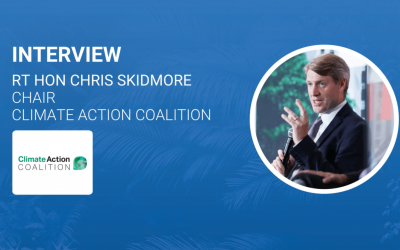ERM on how investors should address climate-related risk while maximizing investment opportunities
Ahead of the Sustainable Investment Forum North America 2021, Climate Action caught up with ERM's North America CEO, Susan Angyal, and Partner & Global Director Climate Change & Low Carbon Economy Transition (LCET), James Stacey, to discuss how investors should anticipate and address climate-related risk while maximizing investment opportunities.

Ahead of the Sustainable Investment Forum North America 2021, Climate Action caught up with ERM's North America CEO, Susan Angyal, and Partner & Global Director Climate Change & Low Carbon Economy Transition (LCET), James Stacey, to discuss how investors should anticipate and address climate-related risk while maximizing investment opportunities.
How should investors anticipate and address climate-related risk while maximizing investment opportunities?
Navigating the potential impacts on financial return of the physical risks of climate change and the disruption that will be caused by the transition to a low carbon economy requires investors to get three critical actions right.
First, to ensure that understanding of climate-related financial risk and opportunity is integrated into their governance, decision-making, risk management, and investment strategy processes.
Second, to gain the capability, capacity, expertise, and access to data required to navigate the climate crisis and the transition to a net zero carbon economy.
And third, to form a view on how different sectors, geographies, and elements of the value chain will be impacted in order to better predict where winners and losers will emerge – and to establish a process for determining how long that perspective remains valid and when it requires update and adjustment.
How is increasing investor interest in ESG affecting corporate strategy?
Since the Paris Agreement was reached in 2015, there has been an enormous shift in investor interest in ESG, with particularly high focus on climate change and related financial risk and opportunity. The pandemic has reinforced this given recognition that systemic issues that are part of the ESG agenda such as climate change, DE&I, biodiversity, and others have tremendous influence on present and future business performance and investor returns.
This has contributed to an ongoing rise in the number of ESG ratings and rankings, which are used by investors to inform investment strategy and selection. A material ESG investment class is emerging and beginning to influence access to and cost of capital. This trend is especially important to corporates, which face material impact when they perform badly on ESG ratings and/or are excluded from the rankings and newly defined investment universes.
Corporates are responding by determining which ESG issues are material to their performance, then acting on their findings and integrating ESG actions into their commercial strategies. In many cases, we now see corporates redefining their medium-term plans, for example by adopting net zero strategies with significant implications for the products they make, the services they offer, and the ways those products and services are produced and delivered. Companies are also adopting frameworks that guide their disclosure to investors, like the Task Force for Climate-related Financial Disclosures, which help present information in a manner more easily understood by the investment community.
A key challenge that corporates grapple with is how to move from high-level strategy to implementation – i.e., understanding how to operationalize their ESG and net zero ambitions. Progress here depends on detailed technical expertise to perform the techno-economic analyses, which underpin the commercial cases for implementation.
How should investors assess companies’ alignment with the transition to a net zero future?
Investors and lenders recognize that, as the world economy decarbonizes, and higher-carbon business models and assets face material restructuring costs or risk being stranded, their investment portfolios and lending books need to align with the transition as well. This recognition is increasingly reinforced by financial regulators’ actions.
Establishing methodologies, metrics, and data solutions to track alignment has become a significant priority for the finance sector writ large. While a number of industry initiatives have started to develop common approaches, there is not yet a universally accepted, off-the-shelf solution available.
Proactive investors and lenders are building systems of their own. For instance, JPMorgan Chase developed a ‘Carbon Compass,’ with ERM support. This tool sets out how JPMorgan Chase will measure the alignment of their Oil & Gas, Power, and Automotive sector exposures with the carbon reduction ambitions embedded in the Paris Agreement. Building such methodologies requires deep climate-related insight and expertise, including understanding how to develop and apply scenarios, how to attribute investee or counter party emissions to an investor or lender, the ability to decide which emissions metrics should be used, and the means to gather related data for the portfolio / lending book.
It is critical to recognize that implementing a net zero or Paris-aligned methodology will have material commercial and strategic implications and is likely to trigger significant decisions with regard to an organization’s approach to some investees or counter parties. Engagement with these parties is therefore critical to ensure the kind of two-way communication required to enable fully informed decision making on all sides.
Clearly, as more investors and lenders implement net zero or Paris-aligned strategies, pressure will grow on corporates to have their own credible and actionable net zero strategies and implementation plans. While many corporates have announced ‘direction of travel’ net zero ambitions, most have significant work to do, for example, in terms of strengthening their greenhouse gas emissions data and/or on operationalizing their net zero strategies through technically informed, practical, and implementable action plans.
Why is the Low Carbon Economy Transition so important to private equity?
The low carbon economy transition presents risks and opportunities for private equity. Given the scale of the industry and its ability to influence hundreds of portfolio companies, private equity has an important role to play in the transition. If a private equity firm chooses to ignore the seriousness of climate change, it may have significant impact on its returns and ability to attract capital, especially from institutional investors. There are tremendous opportunities to direct private capital to climate change solutions; in doing so, it is important to integrate climate-related risk and opportunity into the overall governance and investment process of the private equity firm.
Many private equity firms are evaluating what it means to align their investment activities with net zero principles, including investing in climate solutions and supporting carbon-intense industries on their decarbonization journey. It is also increasingly recognized that ESG and climate-related discussions must occur at the board level of portfolio companies to ensure truly strategic discussions and sharing of insights, as well as adequate oversight management initiatives. In addition, it is vital to focus on climate-related disclosure and transparency. There is a great opportunity for private equity firms to lead in this important transition.
Why would a company want to invest in forward climate scenario analysis? What does best practice look like?
While we have increasing levels of confidence that global governments and businesses will act to limit future greenhouse gas emissions and address the worst possible impacts of climate change, there is still not enough clarity on the speed at which this transition will occur. A number of different decarbonization scenarios could play out, influenced by factors such as government policy, access to capital, and the speed at which clean technologies descend the cost curve.
To determine a company’s financial risks and opportunities, it’s necessary to consider all possible scenarios. Across industries, different scenarios will present materially different financial consequences and warrant different strategic responses. Understanding different scenarios potential influence on future prospects is critical if management is to develop a business plan which will enable the company to survive and thrive in this complex landscape of change.
Best practice today comprises an organization first identifying which scenarios are most relevant and plausible in the context of the business and determining which data sets align with these scenarios. Second, management needs to run these scenarios for relevant segments of the business, then, where material implications emerge, complete sensitivity analyses on the financial models that might be used to respond. These steps help reveal the root causes of financial impact, potential strategic responses, and wider value chain implications, and it is after they are taken that actual climate performance choices can be implemented.
Think Tank
Do you want to learn more about investor strategies for climate resilient portfolios? Download these recent thought leadership reports from the SustainAbility Institute by ERM and sign up for the Institute’s newsletter to stay informed about our future research.
The Changing Climate for Private Equity
From Promise to Action
Rate the Raters
Newsletter sign up
Thanks to ERM's Partner & Global Director Climate Change & Low Carbon Economy Transition (LCET), James Stacey, North America CEO, Susan Angyal and Senior Advisor, ESG and Sustainable Finance, Beth Lowery.
ERM is speaking at the Sustainable Investment Forum North America during Climate Week NYC and you can join them by registering here today.






